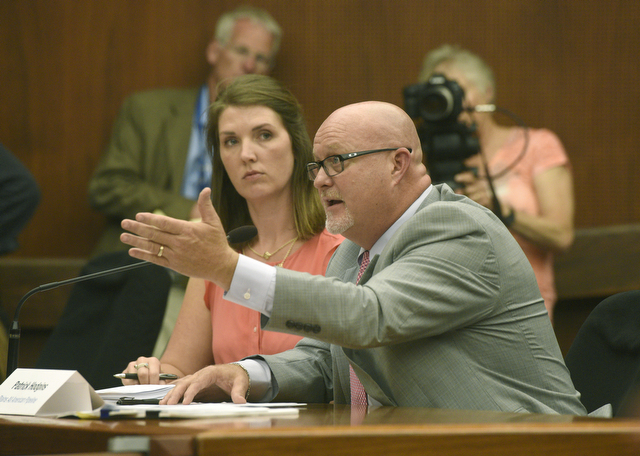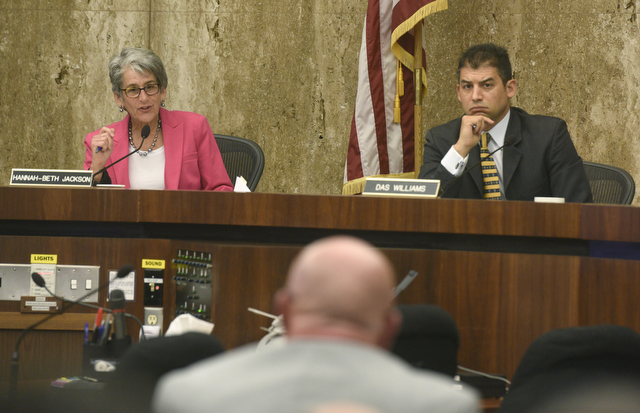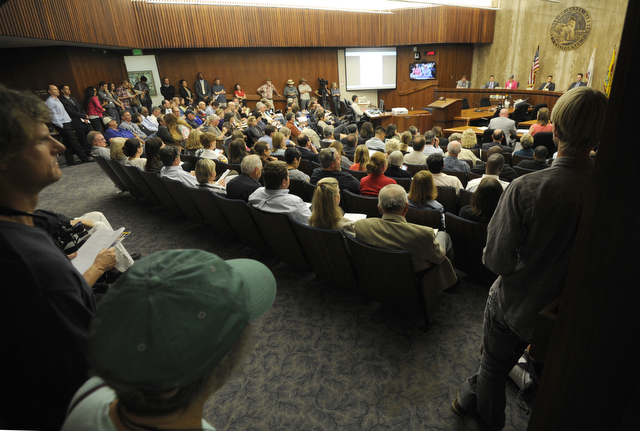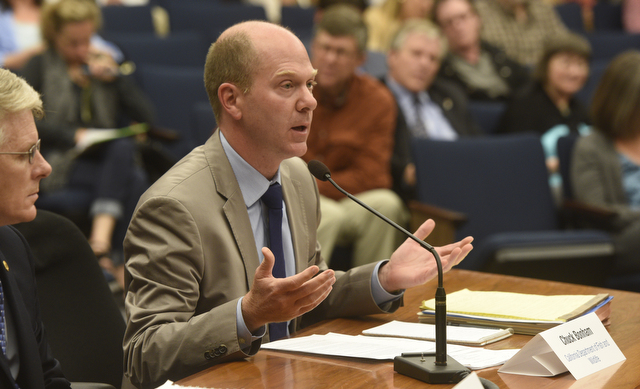Pipeline Company Rep Rope-a-Dopes Williams and Jackson
Oil Spill Hearing Generates More Frustration than Answers

With his stocky torso, cannonball of a head, and imposing biceps, Patrick Hodgins resembled an old-school boxer trained and conditioned to absorb nonstop punishment in the ring. And for much of last Friday afternoon — in oxygen-deprived, jam-packed county supervisors chambers — that’s exactly what Hodgins, now director of Safety and Security for Plains All American Pipeline, did.
Hodgins was clearly the star witness during a joint oversight hearing convened by State Senator Hannah-Beth Jackson and Assemblymember Das Williams “to get answers” about what the pipeline company should have done in response to the May 19 oil spill at Refugio — as opposed to what it actually did. Under prolonged and occasionally peppery questioning by Williams, Jackson, and Santa Cruz Assemblymember Tom Stone — also on hand for the special inquest — Hodgins was relentlessly polite and contrite.

He apologized profusely for the spill — “Just one oiled bird is one too many,” he intoned — and reiterated Plains’ pledge to do whatever it took, regardless of the cost, to clean up Santa Barbara’s worst coastal spill in 25 years. Under questioning, Hodgins never flared or snapped back. At all times, he came across as professional, cooperative, and responsive. But when it came to explaining the $96 million question — why it took Plains nearly three-and-a-half hours to notify the National Response Center that there was an oil spill in the ocean after the company first saw fit to shut down the Refugio pipeline over safety concerns — Hodgins offered up a bundle of non-responses and partial responses that left his questioners obviously frustrated.
When Williams asked directly why the company waited until 2:54 p.m. to make that call — after having shut down the pipeline at 11:30 a.m. — Hodgins answered, “I don’t have that information in front of me Senator Williams.” When repeatedly pressed, Hodgins said any records that could provide “a second-by-second” account of what actually transpired are now in the possession of federal pipeline inspectors investigating the incident.
According to what was understood before last Friday’s hearing, Plains personnel first noted pressure anomalies in the pipeline at 10:30 a.m. and again at 11:30 a.m. on May 19. At that time, Plains employees working at the company’s Midland Texas control center shut down the pipeline by remote-control technology. The first official calls of alarm, however, would not be made by Plains but rather by Santa Barbara County Fire and Sheriff’s personnel. That happened around noon, when they noted an overwhelmingly intense and pervasive petroleum odor and later, oil gushing out of a culvert overlooking the beach with the force and volume of a fire hose. By 12:43 p.m., county emergency personnel would contact the National Response Center — an über-governmental agency responsible for mustering emergency response teams to major disasters both natural and man-made.
It would not be until 1:30 p.m. that Plains would track the origin of the oil spill to land located above the freeway and to a rupture of its Line 901. At 2:54 p.m., a Plains employee in Bakersfield identified only as James finally notified the National Emergency Center that the spill had hit the water and provided some coordinates for where the oil-born contamination actually was. (In documents released earlier in the week, Plains’ Bakersfield team — charged with making emergency notifications — had experienced difficulty communicating with employees at the site, presumably because they were busy trying to erect a berm to block the escaping oil’s path to the sea.)
“Do you think that it’s wise to wait until you see a spill to begin with response?” Williams demanded. “You need to know where it is,” Hodgins replied. Williams asked whether Hodgins felt “a little embarrassed” that county firefighters issued the first notice. Hodgins replied, “We’re deeply sorry for what happened here.”
To the extent Williams got any satisfaction with this line of questioning, it would come from Mark Ghilarducci, director of the Governor’s Office of Emergency Services. Citing a chapter of state law mandating that such reports be made within 30 minutes, Williams asked Ghilarducci whether it appeared Plains had complied with that law. “It doesn’t appear to me that they met the criteria,” Ghiladrucci replied. As to the penalties for such transgressions, Ghilarducci said that would be up to the state’s Attorney General or Santa Barbara District Attorney.
Hodgins’s notable lack of information proved even more vexing to his interrogators when they asked about the advanced level of corrosion that afflicted the stretch of ruptured pipeline. Reports issued by the federal Pipeline and Hazardous Materials Safety Administration (PHMSA) indicated that 82 percent of the metal had been corroded, well beyond the threshold of safety concern. Williams, Jackson, and Stone asked Hodgins numerous questions about the company’s awareness of corrosion and, more specifically, whether the Line 901 inspection the company conducted in 2012 gave any hints of the problems to come.
Hodgins replied variously, “The first time I heard anything about the corrosion is what I read in the newspapers,” and, “We had no indication at all to assume there was an issue.” When Hodgins said he was “shocked” by field measurements showing the severity of the problem, Jackson shot back, “That’s what’s of interest to me — that you’re ‘shocked’ this pipeline was corroded.” Hodgins explained the 2012 inspection results were in the possession of federal pipeline investigators with PHMSA. An exasperated Jackson shot back. “Why do I know more about what caused this than you do?”

Assemblymember Stone seemed especially interested in what the 2012 pipeline inspection results might show, but he, too, got nowhere fast. “I do not have that information in front of me,” Hodgins replied. “It looks like you didn’t come very well prepared to answer questions,” Stone commented. Jackson was blunter. “We’re all a little frustrated we’re getting this dodge-around.”
Since the spill occurred, both Jackson and Williams — speechifying, lefty Dems endowed with eco-minded street cred — introduced a handful of bills designed to tighten up the regulatory safeguards under which oil pipelines must operate. If passed, they would increase the frequency of inspections and require that oil pipelines come with the best available safety technology, including but not limited to automatic shutdown equipment. Currently, the Plains All American Pipeline falls under federal regulatory oversight. Should the Jackson-Williams package gain traction, the state of California — with stiffer safety requirements — could be put in the regulatory driver’s seat.
Perhaps the most quietly devastating witness at Friday’s vent-fest was Dianne Black, a 31-year veteran of the county’s bureaucratic trench warfare. Black is now second in command at Planning and Development, and she testified how every major pipeline operator in the county — except for Plains — equipped their pipes with automatic shutdown systems. The advantage of such equipment, she noted, is that the pipeline shuts down “without human intervention” when a serious problem is detected. Such equipment would not have prevented a leak from occurring, Black said, “but there would have been an earlier reaction, and it could have reduced the oil spilled.”
Hodgins had testified earlier that if a pipeline was to shut down too suddenly, it could cause a huge pressure backlog. He described this phenomenon as “a hydraulic hammer.” He said that under federal regulations, no oil companies are required to use automatic shutdown systems, but insisted that Plains met or exceeded standard practices for the industry. Black noted under questioning that every pipeline bringing crude oil to onshore refineries from offshore platforms comes equipped with automatic shutdown systems. Likewise for a host of other pipelines.
Since 2002, Black said, county regulators have used the California Environmental Quality Act to crowbar oil pipeline operators to use automatic shutdown systems even though federal law does not require it. No companies — with the exception of Plains — have resisted. Most, she added, don’t wait to be told to include such equipment in their project applications. Jackson asked Black if she knew how much the equipment costs. Black didn’t know but noted, “Not as much as they’ve spent already.” To date, Plains has spent $96 million on the cleanup effort, which the company described as 94 percent complete.
By contrast, there was little quiet or subdued about Supervisor Janet Wolf’s testimony. Wolf gave angry expression to Santa Barbara County first responders, government officials, members of the local media, and the public who felt stiff-armed and shunned almost from the start of the cleanup campaign by the Unified Command. The Unified Command was established principally by the United States Coast Guard and the Environmental Protection Agency, but it also included key state agencies and Plains All American Pipeline.
“From the first day of the spill, the expertise and perspective of local elected officials and senior staff were largely dismissed,” she stated. “Santa Barbara County Fire Department first responders were turned away from cleanup activities on the first day of the spill. Further, when the county asserted how to best outreach and communicate with our constituents, our proposals were denied or severely restricted.”
Particularly galling, Wolf said, was the influence asserted by and deference given to Plains All American representatives as members of Unified Command. At the first press conferences held in the wake of the spill, Wolf stated that “Plains executives provided overt messages and were given free rein to make whatever statements or representations, while our county officials’ statements and comments were scrutinized.” A Unified Command press conference, Wolf concluded, was not the appropriate vehicle for Plains “to conduct damage control.”

Wolf blasted state officials, as well, blaming them for blacking out information about the origin of tar balls washing ashore in Manhattan Beach and other communities to the south. Wolf said she was first told that tar ball “fingerprint” results would be made available within five days, but county officials had to ask again on June 8 and June 15. Ultimately, she would find out last week but through media reports and not from Unified Command. It would be Plains itself that revealed that tests showed some, but not all, of the tar balls washing ashore in Manhattan Beach originated with the Refugio Spill.
Speaking with a searing sincerity, Chuck Bonham, Director of California Fish and Wildlife, addressed Wolf’s concerns and took “personal responsibility” for the information blackout. His chief priority, he said, was to gather information as to the cause, extent, and impact of the oil spill. That information, he made clear, would be crucial to the success of any criminal or civil litigation brought against the pipeline company.
“I have important relationships with the Attorney General and the County District Attorney,” he said, “and I’m not going to do anything to jeopardize their ability to make the best case possible.” Bonham acknowledged that state and federal agencies could have done a better job working with the locals, adding, “This is so much more than an individual oil spill.” He noted how the Santa Barbara spill of 1969 gave rise to the modern environmental movement and described the stretch of beach contaminated by the Refugio spill as both “fragile” and “iconic.”
Any Plains officials present had to be unnerved by Bonham’s passion as well as how minutely he said he’d measure every microscopic disruption the oil spill inflicted on the Refugio ecosystem. Working hard on exactly how much it would cost Plains to restore the environment, make compensation, and pay damages, he noted, is a crackerjack team of employees “dominated by egghead economists.”
The meeting took much longer than anticipated; the room grew hot and humid with the heat of so many bodies; 30 members of the public signed speakers’ slips to testify. A few people left, but not many. Williams had to duck out for about 15 minutes while Linda Krop, senior attorney for the Environmental Defense Center, delivered a few cautionary notes. She reminded those present that the figure of 21,000 gallons widely reported to have escaped into the ocean was a number produced by Plains. “I hope people will stop using that figure,” she said. “Once it’s in the water, it’s impossible to quantify.” Likewise, Krop took exception with Plains’ cleanup estimates. “We don’t believe 94 percent of the beaches are clean.”
Given the circumstances, Plains’ Patrick Hodgins did about the best he could have been expected to do. Given that Santa Barbara’s oil spill has already been seized upon by candidates running for U.S. Senate as well the local Congressional seat, Plains and Hodgins will no doubt endure much political heat in the coming months. And given that Plains is the biggest pipeline company in the United States, moving fully one-quarter of all oil and gas produced in the country in its 18,000-mile system, the ramifications could easily transcend the parochial insularity of South Coast environmental politics. Among his many remarks, Hodgins said, “No one ever wants to have a spill like this happen.” He and the rest of Plains might find themselves surprised how true that is.



